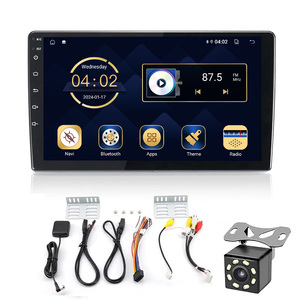
All categories
Featured selections
Trade Assurance
Buyer Central
Help Center
Get the app
Become a supplier

(1155 products available)














































A pioneer head unit is often referred to as a car stereo or a car radio. It's one of the primary components of a car sound system. The head unit is in charge of controlling the audio system and is used for audio source selection and system control. The head unit receives input signals from various sources, amplifies them, and sends them to the speakers. It acts as the command center for the audio system, allowing users to control the sound and select sources. Users can adjust the sound to their preferences using the equalizer, fader, and balance controls.
There are several types of Pioneer head units available, each designed to cater to different preferences and needs. They include:
Specifications for any Pioneer head unit can differ based on the model. Generally, some of the specifications to expect include the following:
While some specifications are constant across all models, others differ. Therefore, users should check individual specifications to get the features they desire.
To maintain a Pioneer head unit, users should observe the following:
Choosing the right head unit for a car can be a daunting task, but it doesn't have to be. By understanding what one needs and considering a few factors, selecting the perfect unit to suit specific needs and preferences will be easier.
The first step in choosing a car stereo system is understanding its importance. A head unit is the control center for a car's audio system. It allows users to listen to their favorite music, radio stations, and other audio content while driving. A good head unit enhances the driving experience. One can listen to music, podcasts, or audiobooks, making every journey more enjoyable and engaging.
Start by evaluating the current car stereo system. Is the sound quality unsatisfactory? Is the user interface difficult to navigate? Is there a need for more connectivity options or additional features like Bluetooth, GPS navigation, or smartphone integration? Understanding the existing system's limitations and determining the desired improvements is essential.
Consider the sound quality and customization options. A head unit with advanced features like equalizers, sound processors, and preamp outputs will offer a more immersive audio experience. These features allow for sound adjustments to match one's preferences and the car's acoustics.
The next step is deciding on a budget. Head units come in various price ranges, so determine how much to spend on the features and sound quality. Remember, investing in a quality head unit will enhance the overall audio experience and add value to the car.
Consider the compatibility of the head unit with the car. Some units may require additional installation kits or adapters to fit correctly in the vehicle. Research the compatibility of the chosen head unit model with the car's make and model.
Consider the ease of use and visibility of the car stereo system. A head unit with a clear display, intuitive controls, and smartphone integration will make it easier to control the audio while driving. Safety should always come first, so choose a head unit that allows for easy and distraction-free control.
Once the decision has been made, it's time to install the new head unit. If one is experienced in car electronics, one can install it independently. Otherwise, it's advisable to have it professionally installed to ensure proper integration and functionality. A professional installation also helps avoid potential damage to the car's electrical system.
Replacing a Pioneer head unit can be a DIY-friendly task, provided that some basic knowledge and skills are available. Here is a step-by-step guide on how to replace a Pioneer head unit:
Tools and materials needed
Steps to replace a Pioneer head unit
Q1: How can one connect a Pioneer head unit to a car's existing speaker system?
A1: Connecting a Pioneer head unit to a car's existing speaker system is typically straightforward. The user should match the wire colors from the head unit to the car's speaker wires. If the car uses a speaker adapter, this makes the process even easier. For detailed instructions, they should refer to the installation manual.
Q2: Can a Pioneer head unit be installed in any vehicle?
A2: Most Pioneer head units are designed to be installed in a wide variety of vehicles. However, the size of the head unit must match the size of the dashboard opening in the vehicle. Additionally, some vehicles may require additional installation kits or adapters.
Q3: What should be done if the Pioneer head unit keeps resetting?
A3: If the Pioneer head unit keeps resetting, users should first check the power connections to ensure they are secure. Also, the voltage supply should be checked to ensure it is within the specified range. If the problem persists, they should contact Pioneer customer support for further assistance.
Q4: Can a Pioneer head unit control a car's Bluetooth systems, like hands-free calls and streaming music?
A4: Yes, many Pioneer head units feature Bluetooth capabilities. This allows users to make hands-free calls and stream music wirelessly from their mobile devices. The user should follow the pairing instructions in the manual to connect their device via Bluetooth.
Q5: What should be done if the touchscreen on a Pioneer head unit stops working?
A5: If the touchscreen on a Pioneer head unit stops working, users should first clean the screen to ensure no dirt or debris interferes with its operation. They should also reset the unit following the instructions in the manual. If the problem continues, they should contact Pioneer customer support.